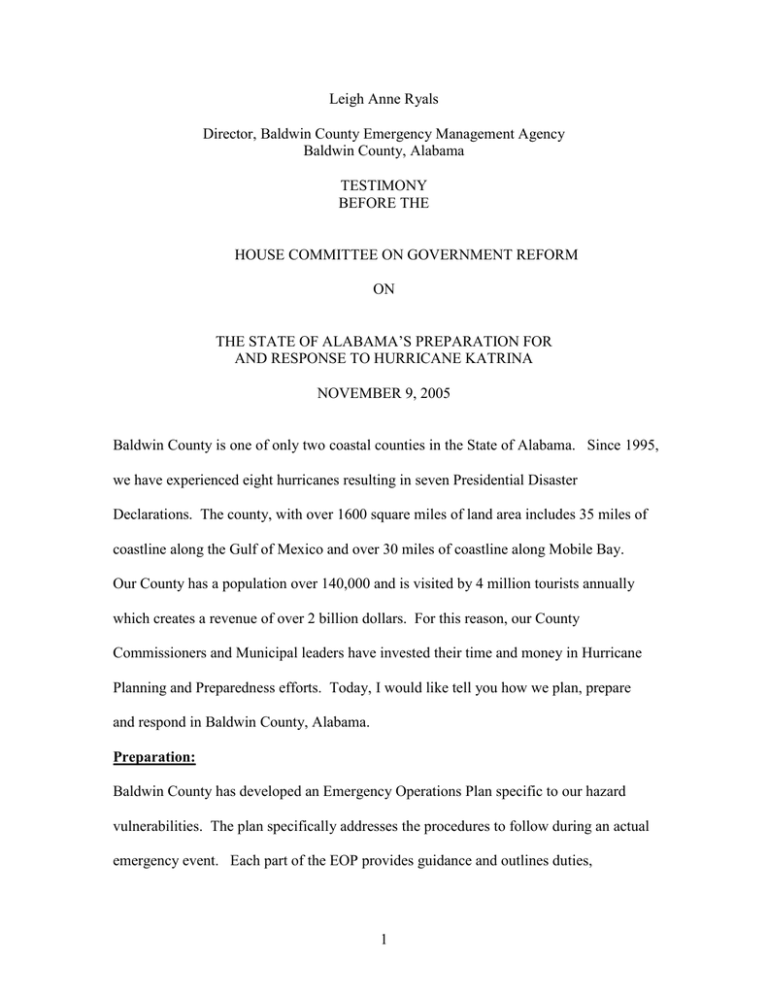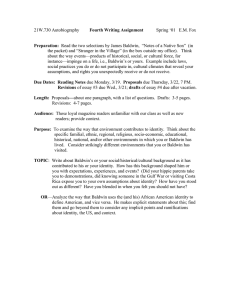Leigh Anne Ryals Director, Baldwin County Emergency Management Agency Baldwin County, Alabama
advertisement

Leigh Anne Ryals Director, Baldwin County Emergency Management Agency Baldwin County, Alabama TESTIMONY BEFORE THE HOUSE COMMITTEE ON GOVERNMENT REFORM ON THE STATE OF ALABAMA’S PREPARATION FOR AND RESPONSE TO HURRICANE KATRINA NOVEMBER 9, 2005 Baldwin County is one of only two coastal counties in the State of Alabama. Since 1995, we have experienced eight hurricanes resulting in seven Presidential Disaster Declarations. The county, with over 1600 square miles of land area includes 35 miles of coastline along the Gulf of Mexico and over 30 miles of coastline along Mobile Bay. Our County has a population over 140,000 and is visited by 4 million tourists annually which creates a revenue of over 2 billion dollars. For this reason, our County Commissioners and Municipal leaders have invested their time and money in Hurricane Planning and Preparedness efforts. Today, I would like tell you how we plan, prepare and respond in Baldwin County, Alabama. Preparation: Baldwin County has developed an Emergency Operations Plan specific to our hazard vulnerabilities. The plan specifically addresses the procedures to follow during an actual emergency event. Each part of the EOP provides guidance and outlines duties, 1 responsibilities and procedures to be performed during emergency activation. It includes evacuation zones and routes, commodities distribution procedures and response coordination. Annual exercises are preformed to test all aspects of our plan. Each year, a special Hurricane training day is held for all first responders and elected officials to review the hurricane annex of the EOP. Further, key municipal and county staff annually attends the National Hurricane conference as well as the State of Alabama Hurricane Conference for additional training. Baldwin County has an active Local Emergency Planning Committee (LEPC) which uses an “all hazards” approach to bring business and industry together to plan and prepare for natural hazards as well as hazardous chemicals. Katrina: Approximately five days prior to the landfall of Hurricane Katrina, consultation was initiated with the National Hurricane Center, State of Alabama Emergency Management Agency and the Mobile office of the National Weather Service to discuss the storm’s strike probabilities, intensity and forecast. Information was immediately disseminated to all local elected officials and first responders. The Emergency Operations Center (EOC) was made ready for the probability of activation. Conference calls were held two to three times daily to track the storms forward movement and projected path. Baldwin County uses a FEMA indorsed software program called Hurrevac to assist emergency managers in the decision making process. This software program provides real time information on storm tracking, projection and guidance for evacuation decision making. Even though the projected path was to our West, we prepared for the potential effects of the storm including, high winds, intense rainfall and a 15 to 17 foot storm surge. Our training and experience has taught us to use 2 the projection as a guide, but to prepare for potential shift in direction, speed and intensity. Baldwin County initiated a partial activation of the Emergency Operations Center for all key personnel on August 27, 2005. During this time, emergency readiness was assessed and decisions regarding evacuation, resources and shelters were made. Elected officials and first responders assembled at the EMA to participate in the conference calls with the National Hurricane Center and the National Weather Service. At this time, EMA distributed 800 MHz radio’s to all Municipal Mayors and County Commissioners to better communicate the needs of the community during and immediately following the storm. A county staff person was assigned to coordinate local officials’ needs. Additionally, the Hamm operator team was contacted to mobilize operations to further enhance communications. An ACU 1000 communications vehicle was obtained through the State EMA to enhance communications capabilities. The information gathered during the conference calls prompted a voluntary evacuation of the coastal communities, flood prone areas and mobile home residents on August 27th. A full activation requires representatives from the Alabama Department of Transportation, utility companies, private relief organizations, National Guard and municipal officials to man the County Emergency Operations Center. The County Voluntary Organizations Active in Disaster (VOAD) was notified and placed on alert. A full activation of the EOC was ordered at 6:00AM on August 28th with a Local State of Emergency declared by the Baldwin County Commission at 9:00AM that same morning. Coordinating with these representatives at the EOC, the Emergency Management staff outlined the potential vulnerabilities for each community and initiated the opening of five 3 county shelters and two special needs shelters. Due to the forecast track and risk potential, a decision was made to utilize the Reverse 911 call down system to alert all citizens in vulnerable areas. (This system has the capability to use GIS mapping to call all homes in the county or site specific areas to warn them of potential danger). Governor Bob Riley issued a mandatory evacuation on August 28th at 1:00PM in coordination with local officials to include; “all Plash Island, Fort Morgan Peninsula, all areas south of Fort Morgan Road in Gulf Shores; residents south of Perdido Beach Boulevard. and all residents living in Perdido Key, also, all low lying and flood prone areas south of I-10”. COMMODITIES DISTRIBUTION COORDINATION: The Baldwin County Emergency Management Agency communicated to citizens to plan and prepare to stay on their own for the first 72 hours. We explained that it may take at least 72 hours to have commodities delivered from the staging areas. This first 72 hours are also utilized by first responders for immediate lifesaving measures. The Emergency Management Agency supplied the EOC with food and supplies to self sustain for up to two weeks. Shelters were supplied with necessary food and materials on August 28th in order to sustain them for 72 hours as well. Our shelter management plan outlines for the American Red Cross to assume shelter management responsibility within 72 hours following the storm event. The Emergency Management Agency utilized the commodities and distribution plan from our EOP for the coordination of ice, water and meals ready to eat (MRE’s) for affected citizens. This plan provides for first responders and State National Guard assets to distribute the needed supplies. Coordination with the State Emergency Management Agency was done in advance of the storm for the staging of expected commodities. Needs are based on anticipated damage assessment, potential 4 power loss and residing population. The commodities were staged outside the affected storm areas for immediate delivery following the storm. Communication: The Baldwin County Emergency Management Agency building is co-located with the Emergency 911facility and houses the Baldwin County Sheriff’s Dispatch office. This provides for a 24 hour focal point for communication and coordination of assets. The EMA office uses the following modes of communication to enhance response; Southern Linc Radios (800 MHz), Cell phones, email, Nextel Radios, Hamm Radio Operators, Satellite phones, EM 2000, local media outlets, mass fax capability, and the Reverse 911 System. Additionally, the EMA office uses Chamber of Commerce personnel who have been trained under the FEMA PIO Course for public information distribution during a crisis. First responders, including Fire Departments, Municipal Police and County Sheriff’s personnel coordinate directly with EMA and with the Sheriff’s dispatch. Response: Immediately following Hurricane Katrina, damage assessment teams comprised of the Baldwin County Tax assessor’s office, Building Officials, Highway Department and Sheriffs personnel, were assembled. The information gathered during the assessment was given to EMA staff for dissemination to Alabama Emergency Management Agency. The assessment is done to determine if the disaster can be handled with local resources or if State and Federal Assistance is needed. It was determined that the extent of Katrina damage was beyond our capability to fully manage. State Emergency Management and FEMA quickly assembled damage assessment teams to provide assistance in the areas of 5 Public and Individual assistance. Commodities staged in Montgomery were delivered to Baldwin County within the 72 hours as anticipated. As per our EOP, EMA coordinated with first responders for the setup and distribution of commodities including ice, water and MRE’s to our affected population. The Red Cross assembled at the seven shelters to assist in consolidation and meeting the needs of the 1,022 Baldwin County Residents residing in the shelters. As the danger passed, many Baldwin County residents were able to return to their homes. It soon became apparent that long term shelters needed to be opened to assist evacuees from Mississippi and Louisiana. At this time, the State of Alabama Emergency Management Agency assisted with other supplies, cots, water, MRE’s, blankets, etc. to help in this effort. It was estimated that we had over 10,000 evacuees. FUNDING: Baldwin County received $52,558 from State and Federal assistance for our EMA program in FY 05. The County Commission’s FY 05 budget provided $336,848.00 to our agency. Due to Hurricane Katrina and the need to enhance our operation, the Baldwin County Commission’s FY 06 budget includes $622,221.00 in funding. In general, this funding is used to pay the salaries of four permanent employees and the overall operation of the 5000sq.ft. EOC. The Baldwin County EMA acts as a coordinating agency for state and federal grant programs assisting in the purchase of equipment needs for local first responders. Over the past several years, all money received from grants has been for the sole purpose of providing terrorist prevention equipment. No money has been made available to promote Hurricane program management from the State and Federal level. 6 Homeland Security Mandates a core committee comprised of Municipal and County representation approve all expenditures made with Homeland Security Grant funding. To date, all funds have been spent for prevention and detection equipment and the development of a countywide hazardous materials trailer. Needs: A Hurricane Evacuation Study was completed for Baldwin and Mobile Counties in 2000. This study considered population data from the 1990 census which grossly underestimated the actual permanent and tourist population of Baldwin County. Due to Baldwin’s rapid population growth, a new study needs to be done taking into consideration tri-state evacuations (Mississippi, Louisiana and Alabama) including transportation modeling, population increases and current shelter capabilities. Additionally, more work needs to be done to develop an enhanced public awareness program for hurricanes. Storm Surge specifically needs to be addressed and the population educated. Finally, FEMA needs to be removed from under the Department of Homeland Security and given back its own identity. Natural Hazard’s planning needs to be brought back to the local level with adequate funding. In closing, I would like to thank you Mr. Chairman and distinguished members of this Committee for providing me this opportunity to represent Baldwin County, Alabama. I appreciate your efforts to enhance Federal, State and Local Emergency Management Agencies as we respond these catastrophic events. 7



